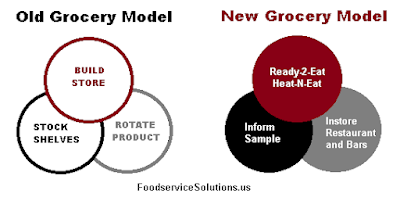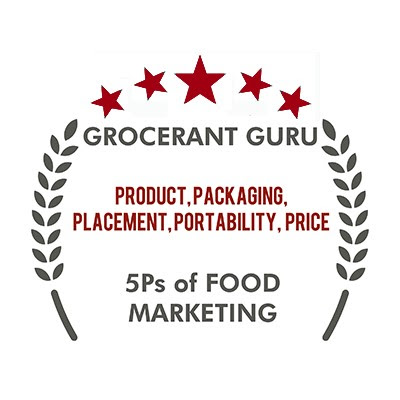Consumers
are dynamic not static and today that means smartphones are fast becoming the
food marketing platform of choice according to Steven Johnson, Grocerant Guru® at Tacoma, WA based Foodservice
Solutions®.
In
a battle for share of stomach C-stores, restaurants, bodegas, and grocery store
delis all need a fresh focus on smartphones. Art Sebastian, vice president of
digital experiences at Casey’s, stated, “Digital engagement is more
important now than ever because that is the way people live… “People expect to
digitally engage with restaurants, c-stores and grocery stores, and as a
channel, we can’t be left out of that.”
Today,
digital engagement for grocerant niche Ready-2-Eat and Heat-N-Eat fresh food
space is not just about getting customers onto the lot, but also getting them
into the store and influencing their purchases once they’re there. Today that
includes digital signage at the forecourt, digital signage in the store — such
as cooler screens and foodservice menu boards, mobile apps, mobile marketing,
loyalty programs and more.
Kevin
Rice, chief marketing officer at San Luis Obispo, Calif.-based Hathway, stated, “To be successful
with digital, c-stores need to think more holistically about consumer
experiences and avoid the shiny object of the week,”.
Rice continued, Digital
properties include websites, apps and digital signage, as well as channels such
as email, SMS, push notifications, and in-app messaging. And it all needs to
connect seamlessly with loyalty and marketing technology, so everything works
together….
“Everything
has to work consistently and seamlessly across every interaction and touchpoint
for your digital strategy to be effective,” he said. “The industry is
convenience, but it’s also the expectation of the customer, and this needs to
be part of the digital strategy.”
How
well do you know your customer? Consider that one of the biggest benefits of
interacting digitally with consumers is the data that can be captured, which
can then help c-store operators make decisions on products, merchandising and
marketing. Capturing and analyzing this data must be part of an overall digital
strategy.
Casey’s Sebastian added, “For us, when you
engage with a customer digitally, you are building data and that is one of the
most powerful aspects we have at the moment”. “This might sound too simple, but
our loyalty program is really doing the job for us,” .. “We have 4.3 million
members and if they use it, they have the mobile app, so we can send push
notifications. This has become the leading driver of in-store conversions.”
So,
Casey’s has been collecting data
through its loyalty program long enough that it can now send personalized
offers to individuals based on their past behavior, the time of day they
typically shop the store, and other metrics. The chain can also track if those
offers are opened and redeemed.
Sebastian
explained, “We now have enough data on members that we know X customer
typically buys a whole pizza every week, so we can app push at day 6 to close
the gap on the purchase,”. “Also, on Saturday at 10 a.m., I can push an offer
for a $1 medium coffee to be redeemed that day and we can track the conversion
rate of all customers who received the app push to see who buys.”
Rice went on to say, many
c-stores offering pay at the pump via a mobile app can utilize this type of
push notification to also get customers from the forecourt into the store. Once
in-store, it often results in them purchasing more than just the deal
offered...“When filling up the gas tank, customers are a captive audience, so
give them a free cup of coffee to get them into the store, or offer a car wash
coupon, or anything else you might have available to them,” … “Give them
something to get into the door and they will probably buy something else as
well.”

Don’t
stop just because they come in the door. The same goes for digital engagement
once a customer is in the store. With consumers spending so much time on their
mobile phones these days, utilizing this to communicate to them allows
retailers to create a personal connection. When someone is logged into an app,
the c-store retailer can know they are there using geolocation, and many have
access to past purchase history and preferences, so they can send a relevant
push notification to entice them to buy.
Casey’s uses Salesforce’s
Einstein artificial intelligence (AI) product to turn its sales data into
business insights, and the chain is optimizing message send times using AI.
Casey’s is also segmenting loyalty members by a variety of metrics, such as
when they open messages, to maximize open rates, Sebastian noted.
“We
do messaging as an app push, an in-app message in the app mailbox, SMS for
those who signed up, and email — all depending on what a person responds best
to,” according to Sebastian.
Many
retailers are also focusing on digital signage and menu boards to engage
customers and encourage more sales. This has become more than simply flashing
products or promotions on a screen. With today’s technology, c-stores can cater
the promotions they display to time of day or seasonality — and this includes
kiosks.
Personalization
and customization are a major area of focus for Casey’s is making sure its
in-store digital screens and menu boards are personalized and showing the most
relevant content at the right time. Sebastian’s goal is to be even more
personalized in this area, targeting what audience they are talking to, what
day of the week, etc.
“We
have digital menu boards, but there is work to do to personalize them and make
them more relevant as well,”
Invite Foodservice Solutions® to complete a
Grocerant ScoreCard, or for product positioning or placement assistance, or
call our Grocerant Guru®. Since 1991 Foodservice Solutions® of Tacoma, WA has been the global leader in the Grocerant niche.
Contact: Steve@FoodserviceSolutions.us or
253-759-7869
























